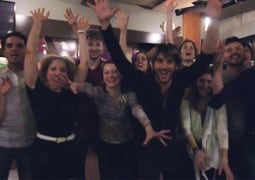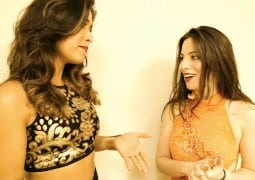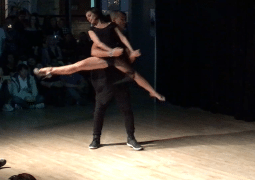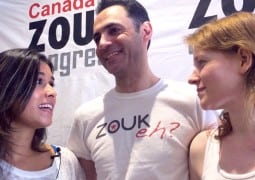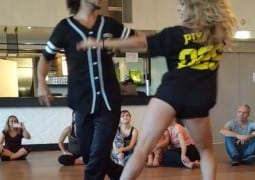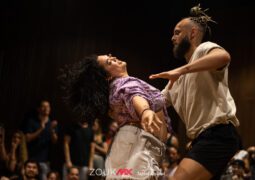SvetLana’s Interview With Rodrigo Delano @ the 2015 Boston Brazilian Dance Festival
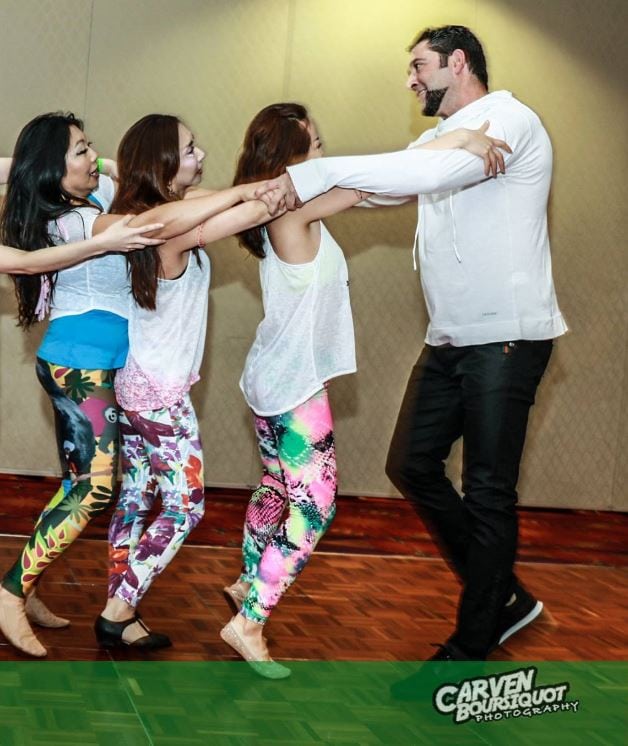
Photo Credit: Carven Boursiquot Photography
This year, I had the pleasure of attending the 2nd annual Boston Brazilian Dance Festival! The Ballrooms of Marriott Hotel were filled with excitement, curiosity and nearly palpable positive energy. The organizers, Inna, Glenio and Edwin (of Moves & Vibes Dance Co.) gathered some of the top Brazilian Zouk artists under one roof, along with hundreds of us Zouk-hungry festival attendees wanting to get the most out of it!
I anticipated that between back-to-back workshops and multiple private lessons the headliners’ schedules would be really tight and was crossing my fingers for a chance to talk to Rodrigo Delano, the artist who not only witnessed the origins of Brazilian Zouk dance, but had direct impact on its development. What really took me by surprise was how easily Rodrigo agreed to speak to me, and how sincerely he made an effort to find the time for it! He is truly a wealth of knowledge about this dance, and his warm and open personality makes him a great conversationalist. I am very thankful for our meeting, and it is my pleasure to be sharing what I learned with Zoukology readers.
Let’s talk about the precursor of Zouk, Lambada. How did it begin and what happened to it eventually?
Rodrigo: Lambada was like a fever. It started in 1987-1988 and picked up really quick. It stayed popular for about four years but by 1992 its popularity started declining, just many other trends in Brazil around that time. Everything was going in and out of fashion fast. One of the main Lambada bands, Kaoma, stopped producing the music. A different type of music, Axé, became the new craze. It got a lot of attention from the television, which was how the trends were created back then. And that’s when Lambada almost disappeared. Only small groups of people could be found dancing it, and they had to search for a different music to dance to. They eventually adapted the steps to Zouk music, a genre originated from the Caribbean islands.
How were you first introduced to Lambada?
Rodrigo: I started with styles such as Samba, Bolero and Forró, some of the most popular partner dances in Brazil. When I was 11-years-old, Lambada appeared on the dancefloors and I started dancing it too. I witnessed how it rose and declined, and how it transformed into Zouk.
How did the scene keep evolving?
Rodrigo: After the period of about 8 years when Zouk was very hard to find (1992-2000), it slowly began growing popular again. In 1999 I started a project in my city, Belo Horizonte, called House of Zouk. It became our yearly tradition to travel to Porto Seguro with a group of about 50 people for the holidays, for dancing. Another dancer, Berg Dias, was bringing some Zoukers from Europe to Porto Seguro as well, but during the Carnival time. I approached him offering to join forces since the Zouk scene was still relatively small. And together we organized the first congress on New Year’s Eve 2005, with approximately 300 attendees. It inspired other event organizers; more festivals took place, and a new wave of Zouk began. Berg continued holding the New Year’s Eve congress regularly, while I focused on growing the scene in my city.
How did the name “Brazilian Zouk” come about?
Rodrigo: In 2006 we had a Zouk teacher conference in Belo Horizonte and we were discussing its name. At the time it was referred to as both “Lambada” and “Zouk.” I proposed to call it “Brazilian Zouk,” since it was a dance to Zouk music coming from Brazil. There were other names suggested such as Zouk Lambada, Lambada Zouk, Zouk of Brazil (and others), but after a discussion everyone agreed on Brazilian Zouk. Thinking back, I would actually have preferred if we kept the name “Lambada” which is more authentic to our culture.
These days there are so many styles and variations of Brazilian Zouk, is there a way you can classify all of them?
Rodrigo: When Lambada music started being replaced by Zouk, the dance started changing as well. Dancers were paying attention to the melody more, not just the rhythm. This was the beginning of what’s now referred to as a Traditional Zouk. With time, various music genres influenced a myriad of styling variations. So I prefer to classify Zouk by the three main “lines,” rather than styles. First is Lambazouk, we start the dance with the two quick steps – “quick-quick, slow.” Another line is a Traditional Zouk, which starts with a slow step – “slow, quick-quick.” And the third line is Stylized Zouk, when the elements of other dances are added, such as West Coast Swing, Salsa, or Hip Hop. Within these three “lines” there are many different styles.
What’s your style?
Rodrigo: That’s a fun question! Some people say I dance Lambazouk, others say Traditional Zouk or Stylized Zouk. But I just say I just dance Zouk, because I use different techniques. Most of the time I stay within Traditional Zouk, with some additions from other lines. If I dance with someone who has a modern dance background, I can use elements from Stylized Zouk if it goes well with the music. If a Lambazouk song is playing and my partner knows how to dance it, then we’ll dance Lambazouk. To me the main goal is to enjoy the dance with my partner, and to enjoy the music we are dancing to.
I learned that you incorporate dynamical systems theory into your teaching approach. What is it and how does it relate to dance?
Rodrigo: Dynamical systems theory is a theory about movement. Movement of planets, bodies, animals, etc. There are different applications. It studies movement that happens organically, governed by the natural laws (e.g. laws of physics), as opposed to movement produced intentionally (e.g. commands generated by human brain). I look into how these ideas could be applied to dance training, how the laws of physics could be used when learning dance steps. There is a common opinion that we have to think before we can move. We put the brain before the body. Dynamical systems theory treats the brain and the body equally. It says that the brain is involved, but the body knows its way too, guided by the physical laws. This idea allows for some creative movement exploration and challenges us to not rely entirely on the brain. Children learn this way. They don’t think how to move, they just move.
Could you please tell us about your connection to the Brazilian Zouk Dance Council? What is this organization and what does it do for Zouk?
Rodrigo: I have been supporting the idea of Brazilian Zouk instructors getting together and organizing the scene for a long time now. Because sometimes when there is no structure, no guidelines at all, the dance can get diversified too much and the controversies start. It happened to the name of the dance at some point. People started referring to different styles of Zouk almost as if they were different dances; tribal Zouk, neo-generation Zouk, Zouk R’n’B and many other names. But these days the dance is known as Brazilian Zouk, so that was the first step towards unifying the scene. The second step would be to create a vocabulary of basic Zouk moves. So that if you learn the foundations of the dance in one country and then go to a different place, you don’t have to start learning from scratch again. These are some of the ideas Brazilian Zouk Dance Council is working on. Along with presenting the professional side of Zouk to the world. I think it’s a really great idea. It’s not always easy, as all of us live in different countries, and it requires a lot of time and effort, but it’s important to keep going.
You created the choreography for International Zouk Flashmob this year, how was you experience with this?
Rodrigo: The idea of flashmob is to increase the awareness about the dance. I thought that some of the past routines might have been too hard for beginners and the goal is to bring everyone together. When I was preparing this choreography I had 4 things in mind. First was to try and showcase all 3 lines of. Second, to promote Zouk to the world. Third, to introduce a new step. Fourth, to highlight Zouk musicality, its rhythm and accents, and Zouk foundations. And even though I prioritized making this choreography accessible to beginners, I made one part slightly more difficult, to challenge those who are familiar with the dance. I really enjoyed working on it! Its a lot of responsibility; to create a dance for 50 countries and more than 100 cities. It was a hard work. I spend two months just thinking it through, choosing the music. After the flashmob people all over the world were saying they had fun doing it, so I think I did my job well. It’s a really nice idea to take the dancing outside, so that everyone can see and learn about it. It’s perfect!
What do you think about the future of Zouk? Will it continue to grow, what can we do to help growing it? Will it ever become as big as Salsa, for example?
Rodrigo: Maybe now Zouk growth plateaued a little bit after it grew initially, and that’s normal. Giving the dance more structure is what will help us to go forward, I believe. And another problem these days is that some people attempt to become teachers as soon as they start dancing themselves! If their students don’t have any point of reference for the dance and don’t know how to tell if the instructor is qualified, they will trust in whatever that person is teaching, whether it’s correct or not. So I think that if we keep promoting really knowledgeable instructors, keep clarifying Zouk basics and continue uniting the scene, Brazilian Zouk will start getting more attention again. And yes, I think it is possible for it to reach the volume of the Salsa scene one day.
Tags BBDFBoston Brazilian Dance FestivalEdwinGlenioinnaRodrigo Delanozouk
- Previous Video: New Artists Alert – Alisa & Akash Demo @ the Mega Zouk & Samba Festival in Vienna
- Next Video: International Zouk Day 2015 in New York City
You may also like...
Sorry - Comments are closed


